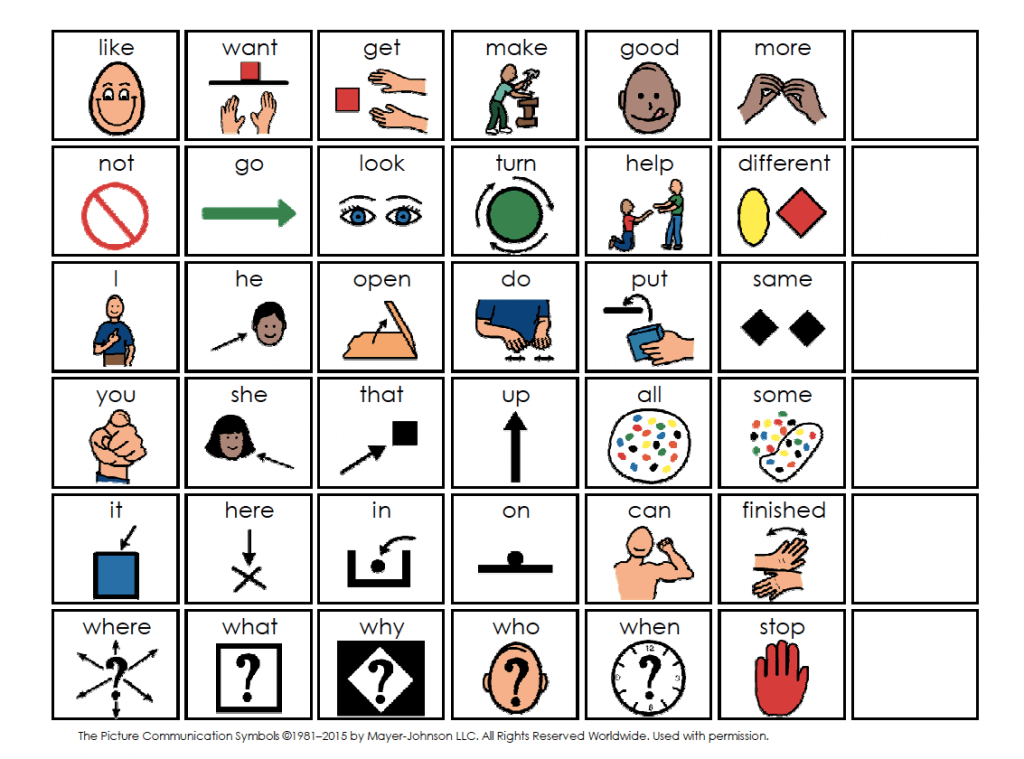“Choose your words wisely” is an expression often said as a reminder of the great power, influence, and impact our words hold. The specific words we choose to express our thoughts, ideas, opinions, personalities and have the ability to shape and alter our surroundings. In the context of Alternative and Augmented Communication (AAC), “choose your words wisely” takes on a whole new level of importance as individuals who use AAC are often limited by a finite amount of words to express an infinite amount of thoughts, emotions, and opinions.
There has been a great deal of research within the AAC literature regarding vocabulary selection and the importance of core and fringe vocabulary. Core vocabulary is considered high-frequency words that are used across all contexts (e.g., it, want, go, I, that, more, no). In contrast, fringe vocabulary is composed of words that occur infrequently are very specific (e.g., basketball, hoop, net). Core vocabulary occurs much more frequently in language, in fact, 80% of the words we say on a daily basis are comprised of core vocabulary and only 20% fringe vocabulary.
When thinking of augmented language systems, it is tempting to focus instruction entirely on fringe vocabulary/nouns. After all, fringe vocabulary words are often more meaningful to the individual, concrete, and easily represented with an image which makes them easier to teach. Fringe vocabulary is an important aspect of communication, however, if we exclusively teach fringe vocabulary we are severely limiting the communicative capacity of the individual. Teaching core vocabulary can be very empowering as it provides the individual with versatile words to create several original utterances across any context.
Modeling Core Vocabulary Across Context
Whether your student uses a speech generating device, I-pad, a picture exchange system, or any other form of AAC, it is critical to model core vocabulary. A no-tech option I love to model core language with are the boards (pictured below) from Project Core available to download for free at: http://www.project-core.com/core-communication-systems/. The board features 36 core vocabulary words with an empty row where fringe vocabulary may be attached with Velcro.
Even if your student has a more advanced communication system, such as a dedicated speech generating device, I think it is great to have a no-tech option available that the student is familiar with for days when the device gets left at home, the batteries on the device are dead (we’ve all been there right?!), or just as a supplemental form of communication. I’ve even seen a laminated version of these boards fixed to a kickboard to support a child’s communication in a swimming pool!
So how do you use it?
Simply point to the core words as you say them. Remember, it is not necessary to model every word in your spoken sentence. I once used these boards while doing push-in therapy for an SDC class during yoga time. The teacher had a large poster of the core vocabulary board at the front of the class and pointed to words as she gave verbal instructions. The instructor would say things like “stand up” and point to the up icon on the core board, “turn your head” while touching the turn symbol, “put your hands on your head” and so on so forth. The aids in the classroom also reinforced the instruction by modeling on individual boards and encouraging the student to touch the picture as they did the action. This is just one example of how core vocabulary can be infused into a variety of routines and settings.
Author: Allison Laubenstein, MS, RPE-SLP
References:
- Cannon, B. & Edmond, G (2009, April 14). A Few Good Words: Using Core Vocabulary to Support Nonverbal Students. The ASHA Leader.
- Center for Literacy and Disability Studies (2013). Dynamic Learning Maps™ Core Vocabulary
- Core Vocabulary (n.d.). Retrieved October 11, 2018 from https://aaclanguagelab.com/resources/core-vocabulary
- Grether, S. (2011) Recognition and Response: Application for Augmentative Communication in Preschool Settings. Presented at Annual Conference for the American Speech, Language, and Hearing Association, San Diego.
- Hatch, P., Geist, L., and Erickson, K. (2015). Teaching Core Vocabulary Words and Symbols to Students with Complex Communication Needs (PDF) Presented at Assistive Technology Industry Association, 2015.
- Van Tatenhove, G. M. (2009). Building Language Competence With Students Using AAC Devices: Six Challenges. Perspectives on Augmentative and Alternative Communication, 18(2), 38–47.
- Van Tatenhove, G.M. (2013). Modeling on an AAC System with Students with Visual, Auditory, and/or Motor Processing Challenges (PDF)
- Zangari, C., and Paiva, S. (2012). Look Who’s Talking: A Curricular Approach to Core Language Instruction for Prekindergarten Children with AAC Needs. Presented at ISAAC 2012.

